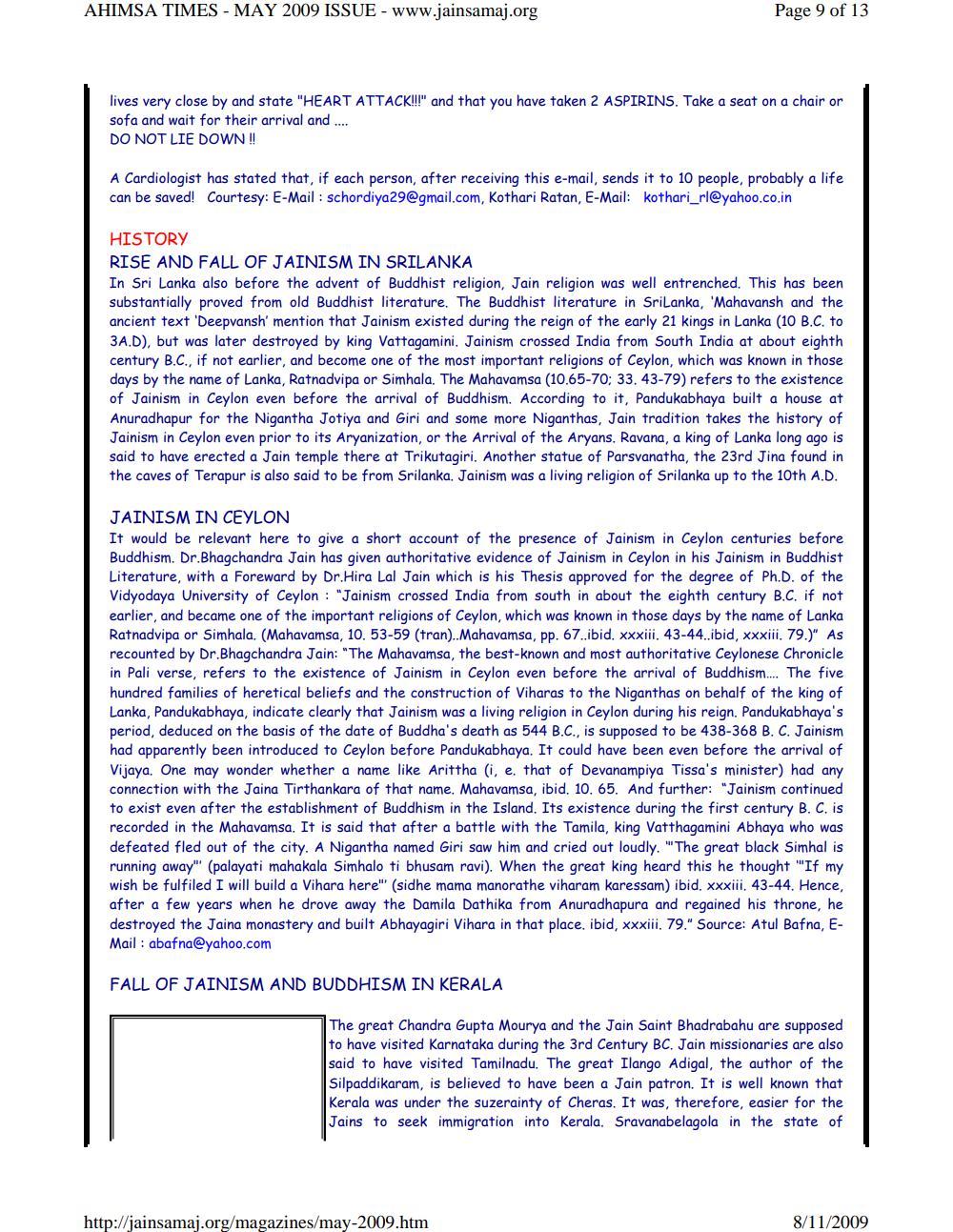________________
AHIMSA TIMES - MAY 2009 ISSUE - www.jainsamaj.org
Page 9 of 13
lives very close by and state "HEART ATTACK!!!" and that you have taken 2 ASPIRINS. Take a seat on a chair or sofa and wait for their arrival and .... DO NOT LIE DOWN !!
A Cardiologist has stated that, if each person, after receiving this e-mail, sends it to 10 people, probably a life can be saved! Courtesy: E-Mail:
[email protected], Kothari Ratan, E-Mail:
[email protected]
HISTORY RISE AND FALL OF JAINISM IN SRILANKA In Sri Lanka also before the advent of Buddhist religion, Jain religion was well entrenched. This has been substantially proved from old Buddhist literature. The Buddhist literature in SriLanka, 'Mahavansh and the ancient text 'Deepvansh' mention that Jainism existed during the reign of the early 21 kings in Lanka (10 B.C. to 3A.D), but was later destroyed by king Vattagamini, Jainism crossed India from South India at about eighth century B.C., if not earlier, and become one of the most important religions of Ceylon, which was known in those days by the name of Lanka, Ratnadvipa or Simhala. The Mahavamsa (10.65-70; 33. 43-79) refers to the existence of Jainism in Ceylon even before the arrival of Buddhism. According to it, Pandukabhaya built a house at Anuradhapur for the Nigantha Jotiya and Giri and some more Niganthas, Jain tradition takes the history of Jainism in Ceylon even prior to its Aryanization, or the Arrival of the Aryans, Ravana, a king of Lanka long ago is said to have erected a Jain temple there at Trikutagiri. Another statue of Parsvanatha, the 23rd Jina found in the caves of Terapur is also said to be from Srilanka. Jainism was a living religion of Srilanka up to the 10th A.D.
JAINISM IN CEYLON It would be relevant here to give a short account of the presence of Jainism in Ceylon centuries before Buddhism. Dr.Bhagchandra Jain has given authoritative evidence of Jainism in Ceylon in his Jainism in Buddhist Literature, with a Foreward by Dr.Hira Lal Jain which is his Thesis approved for the degree of Ph.D. of the Vidyodaya University of Ceylon : "Jainism crossed India from south in about the eighth century B.C. if not earlier, and became one of the important religions of Ceylon, which was known in those days by the name of Lanka Ratnadvipa or Simhala. (Mahavamsa, 10. 53-59 (tran)..Mahavamsa, pp. 67. ibid. xxxiii. 43-44. ibid, xxxiii. 79.)" As recounted by Dr.Bhagchandra Jain: "The Mahavamsa, the best-known and most authoritative Ceylonese Chronicle in Pali verse, refers to the existence of Jainism in Ceylon even before the arrival of Buddhism.... The five hundred families of heretical beliefs and the construction of Viharas to the Niganthas on behalf of the king of Lanka, Pandukabhaya, indicate clearly that Jainism was a living religion in Ceylon during his reign. Pandukabhaya's period, deduced on the basis of the date of Buddha's death as 544 B.C., is supposed to be 438-368 B. C. Jainism had apparently been introduced to Ceylon before Pandukabhaya. It could have been even before the arrival of Vijaya. One may wonder whether a name like Arittha (i, e. that of Devanampiya Tissa's minister) had any connection with the Jaina Tirthankara of that name, Mahavamsa, ibid. 10. 65. And further: "Jainism continued to exist even after the establishment of Buddhism in the Island. Its existence during the first century B. C. is recorded in the Mahavamsa. It is said that after a battle with the Tamila, king Vatthagamini Abhaya who was defeated fled out of the city. A Nigantha named Giri saw him and cried out loudly. "The great black Simhal is running away" (palayati mahakala Simhalo ti bhusam ravi). When the great king heard this he thought "If my wish be fulfiled I will build a Vihara here" (sidhe mama manorathe viharam karessam) ibid. xxxiii. 43-44. Hence, after a few years when he drove away the Damila Dathika from Anuradhapura and regained his throne, he destroyed the Jaina monastery and built Abhayagiri Vihara in that place. ibid, xxxiii. 79." Source: Atul Bafna, EMail :
[email protected]
FALL OF JAINISM AND BUDDHISM IN KERALA
The great Chandra Gupta Mourya and the Jain Saint Bhadrabahu are supposed to have visited Karnataka during the 3rd Century BC. Jain missionaries are also said to have visited Tamilnadu. The great Ilango Adigal, the author of the Silpaddikaram, is believed to have been a Jain patron. It is well known that Kerala was under the suzerainty of Cheras. It was, therefore, easier for the Jains to seek immigration into Kerala. Sravanabelagola in the state of
http://jainsamaj.org/magazines/may-2009.htm
8/11/2009
